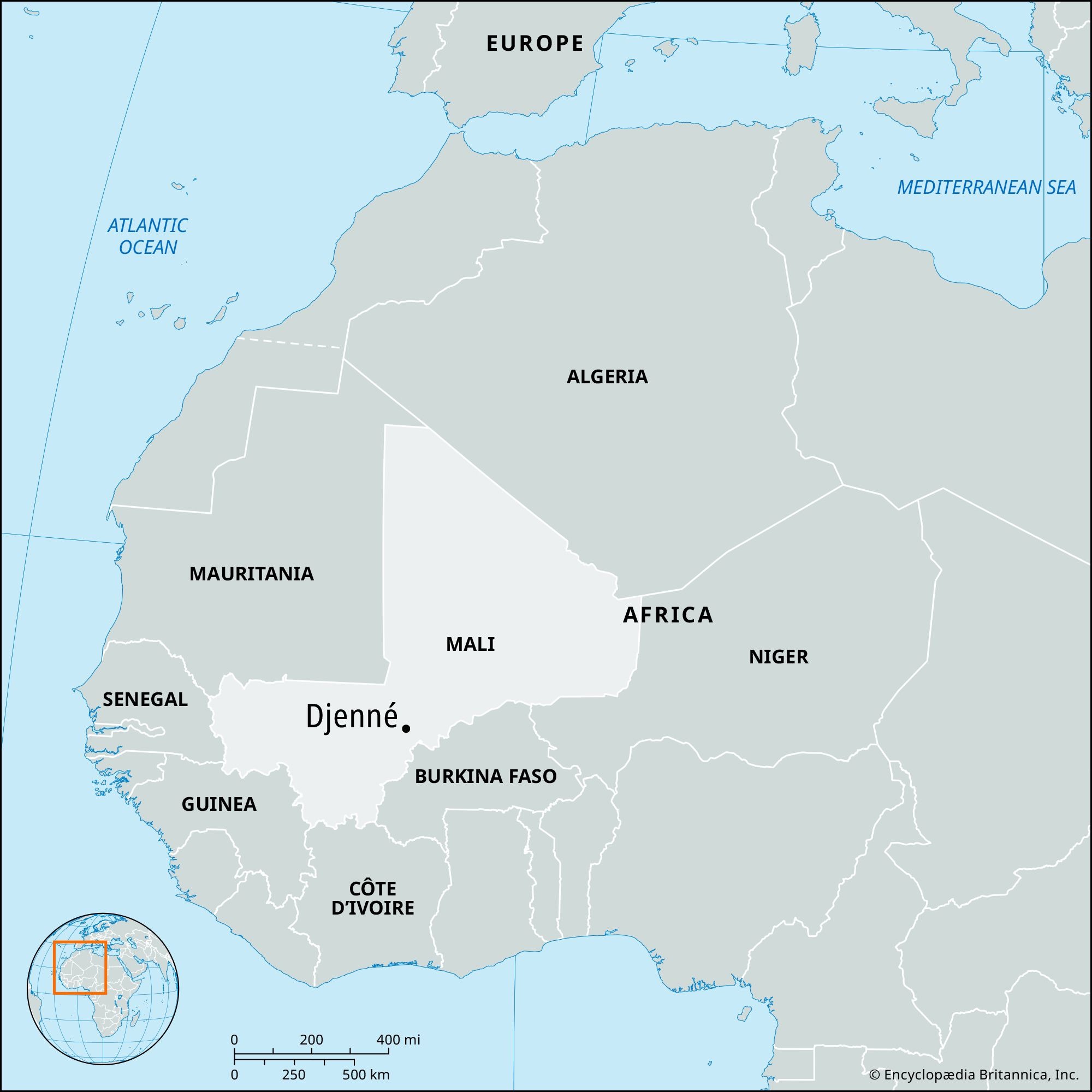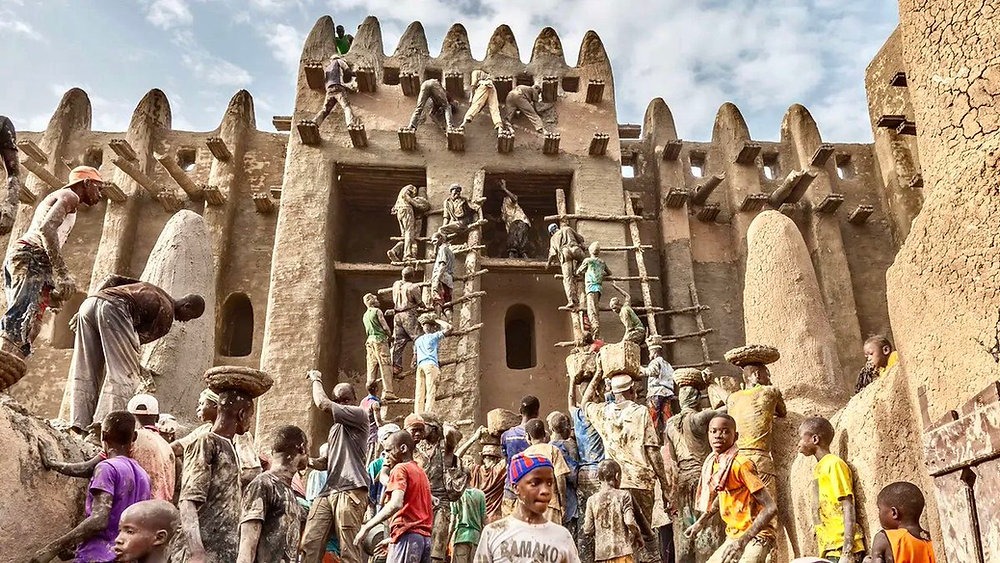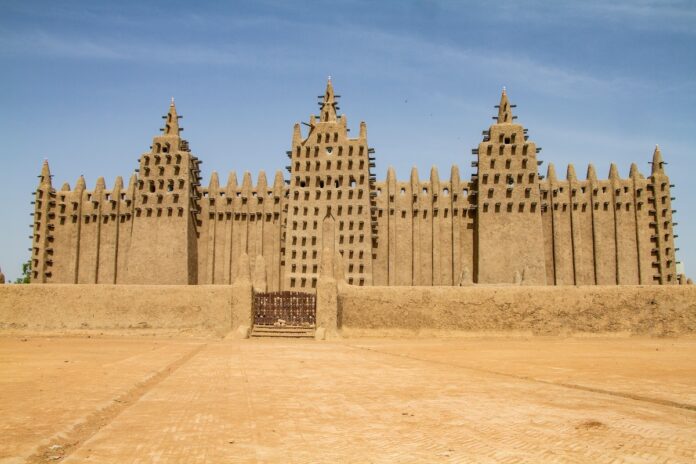Rising majestically in the heart of Mali, the Great Mosque of Djenné stands as a testament to Africa’s rich architectural and cultural heritage. Regarded as the largest mud-brick structure in the world, this iconic mosque is not only a place of worship but also a symbol of resilience, community, and artistic brilliance. Let’s explore the history, significance, and enduring legacy of this architectural marvel.
Origins and Early History
Djenné, one of West Africa’s oldest cities, was founded around 800 AD and became a vital hub for trade, Islamic scholarship, and culture. It flourished due to its strategic location along trans-Saharan trade routes, connecting merchants from North Africa, West Africa, and the Middle East. Gold, salt, and textiles were exchanged here, making Djenné a prosperous urban center.

Islam reached Djenné through merchants and scholars in the 13th century, and as the faith spread, so did the need for grand mosques. The first Great Mosque of Djenné was built in the 13th or 14th century under the reign of King Koi Komboro, who converted to Islam and commissioned the mosque on the site of his former palace. This marked the beginning of Djenné’s transformation into a significant center of Islamic learning and spirituality.
The Reconstruction of 1907
The original Great Mosque eventually fell into disrepair, and by the 19th century, it was in ruins. The mosque seen today was rebuilt in 1907, under the guidance of French colonial administrators and local leaders. While staying true to the Sudano-Sahelian architectural style, this new structure incorporated some modern reinforcements, ensuring its longevity.

The reconstruction was not just an architectural project but a cultural and spiritual revival. The people of Djenné, recognizing the mosque’s historical and religious importance, took pride in restoring this sacred space, reaffirming their commitment to their Islamic and architectural traditions.
Architectural Marvel
The Great Mosque of Djenné is a striking example of Sudano-Sahelian architecture, a style characterized by:
- Sun-dried mud bricks (ferey), reinforced with shea butter and straw for durability.
- Massive walls and towers, adorned with wooden beams (toron), which serve both as aesthetic elements and practical scaffolding for annual repairs.
- A raised platform, protecting the mosque from seasonal floods of the Bani River.
- Three grand minarets, each capped with an ostrich egg, symbolizing purity and fertility.
The mosque’s mud-brick construction keeps the interior cool, providing natural insulation from the scorching Malian sun. This eco-friendly, sustainable design is a prime example of African ingenuity in adapting to environmental conditions.
A Living Monument: The Annual Crepissage Festival
One of the most fascinating aspects of the Great Mosque is its annual maintenance ritual, the Crepissage de la Grande Mosquée (Plastering of the Great Mosque). Each year, the people of Djenné come together to repair and replaster the mosque’s walls using fresh mud, preserving its grandeur for future generations.
This community event is not just about maintenance—it’s a festival! Accompanied by music, dancing, and celebrations, the Crepissage is a powerful demonstration of communal spirit, where young and old alike take part in the preservation of their cultural heritage.
Cultural and Historical Significance
The Great Mosque of Djenné is more than just an architectural wonder; it is a center of Islamic scholarship and education. For centuries, Djenné, alongside Timbuktu, was a hub of learning, attracting scholars, students, and traders from across Africa and beyond. Even today, the mosque remains an active place of worship and cultural pride.
Recognized as a UNESCO World Heritage Site in 1988, the mosque symbolizes the rich history of the Malian Empire and West Africa’s Islamic heritage. It continues to inspire architects, historians, and cultural enthusiasts worldwide.
Challenges and Preservation Efforts
Despite its enduring beauty, the Great Mosque faces threats from:
- Climate change, which affects the durability of the mud-brick walls.
- Political instability in Mali, making conservation efforts challenging.
- Restrictions on non-Muslim visitors, which limit global awareness and funding for its upkeep.
International and local conservationists are working to preserve this UNESCO-listed treasure, ensuring that future generations can marvel at its splendor.
The Great Mosque of Djenné is not just an architectural gem; it is a living symbol of African innovation, Islamic heritage, and community resilience. From its humble mud-brick walls to its grand minarets, every inch of this mosque tells a story of faith, craftsmanship, and unity.
As it continues to stand tall against the test of time, the Great Mosque remains a beacon of African excellence—one that reminds us of the power of tradition, the beauty of collective effort, and the enduring spirit of Djenné’s people.


Hey there I am so excited I found your webpage, I
really found you by error, while I was browsing
on Bing for something else, Regardless I am here now and would just like to say thanks a lot
for a fantastic post and a all round thrilling blog (I also
love the theme/design), I don’t have time
to read through it all at the minute but I have book-marked it
and also added your RSS feeds, so when I have time I will be back to read a lot
more, Please do keep up the awesome job.
Excellent beat ! I would like to apprentice whilst you amend your web site, how could i subscribe for a blog site?
The account helped me a acceptable deal. I were tiny bit familiar of this
your broadcast offered vibrant transparent idea
I simply could not depart your web site prior to suggesting that
I extremely enjoyed the standard information an individual supply in your visitors?
Is going to be back often in order to investigate cross-check new posts
Thank you a lot for sharing this with all people you
actually realize what you are speaking about! Bookmarked.
Please also seek advice from my website =). We will have a link change arrangement between us
Highly energetic blog, I loved that bit.
Will there be a part 2?
Great goods from you, man. I’ve understand your stuff previous to and you’re just too excellent.
I actually like what you’ve acquired here, really like what you’re
saying and the way in which you say it. You make it enjoyable and you still take care of to keep it sensible.
I can not wait to read much more from you.
This is really a great website.